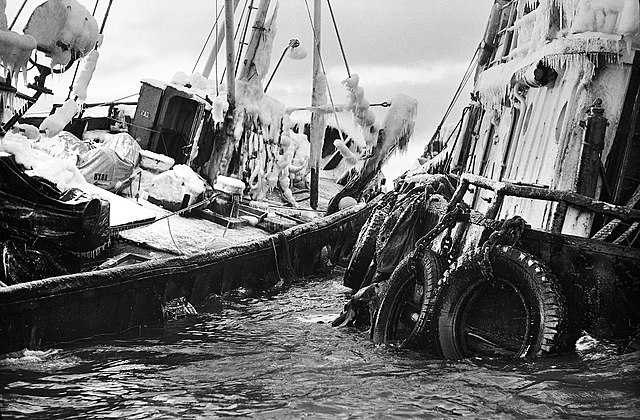
Marine salvage
Recovering a ship or cargo after a maritime casualty / From Wikipedia, the free encyclopedia
Dear Wikiwand AI, let's keep it short by simply answering these key questions:
Can you list the top facts and stats about Marine salvage?
Summarize this article for a 10 year old
Marine salvage is the process of recovering a ship and its cargo after a shipwreck or other maritime casualty. Salvage may encompass towing, lifting a vessel, or effecting repairs to a ship. Protecting the coastal environment from oil spillages or other contaminants from a modern ship can also be a motivator, as oil, cargo, and other pollutants can easily leak from a wreck.[1]
This article has multiple issues. Please help improve it or discuss these issues on the talk page. (Learn how and when to remove these template messages)
|

Before the invention of radio, salvage services would be given to a stricken vessel by any passing ship. Today, most salvage is carried out by specialist salvage firms with dedicated crews and equipment.[2] The legal significance of salvage is that a successful salvor[notes 1] is entitled to a reward, which is a proportion of the total value of the ship and its cargo. The bounty is determined subsequently at a "hearing on the merits" by a maritime court in accordance with Articles 13 and 14 of the International Salvage Convention of 1989. The common law concept of salvage was established by the English Admiralty Court and is defined as "a voluntary successful service provided in order to save maritime property in danger at sea, entitling the salvor to a reward"; this definition has been further refined by the 1989 Convention.
Originally, a "successful" salvage was one where at least part of the ship or cargo was saved; otherwise, the principle of "No Cure, No Pay" meant that the salvor would get nothing. In the 1970s, a number of marine casualties of single-skin-hull tankers led to serious oil spills. Such casualties were discouraging to salvors, so the Lloyd's Open Form (LOF) made provision that a salvor who attempts to reverse environmental damage will be paid, even if unsuccessful. This Lloyd's initiative was later incorporated into the 1989 Convention.
All vessels have an international duty to give reasonable assistance to other ships in distress for saving lives, but there is no obligation to try to salve the vessel. Any offer of salvage assistance may be refused; if it is accepted, a contract automatically arises to give the successful salvor the right to a reward under the 1989. Typically, the ship and salvor will sign up to an LOF agreement so that the terms of salvage are clear. Since 2000, it has become standard to append a SCOPIC ("Special Compensation – P&I Clubs") clause to the LOF to ensure that a salvor does not abuse the aforementioned environmental policy stated in the 1989 Convention (pursuant to the case of The Nagasaki Spirit).[3]
The techniques applied in marine salvage are largely a matter of adapting available materials and equipment to the situation, which are often constrained by urgencies, weather and sea conditions, site locations, and financial considerations. Diving is considered to be counterintuitive, but may be the only, or most efficient, way to complete the salvage job.[4]: Ch. 4 Salvage work includes towing an abandoned or disabled vessel which is still afloat to safety, assisting in fighting a fire on board another vessel, refloating sunk or stranded vessels, righting a capsized vessel, recovering the cargo, stores, or equipment from a wreck, or demolishing it in place for scrap. The work may be done for profit, clearing a blocked shipping lane or harbour, or for preventing or limiting environmental damage.